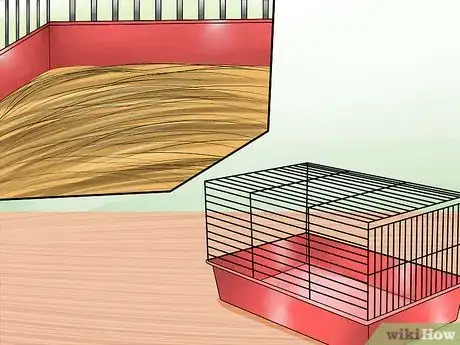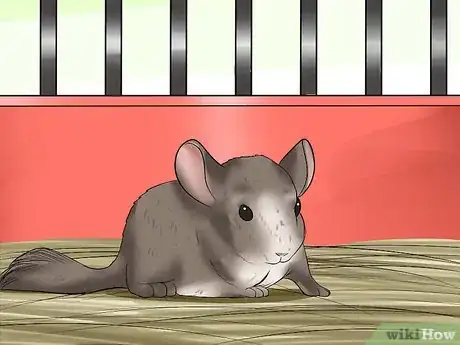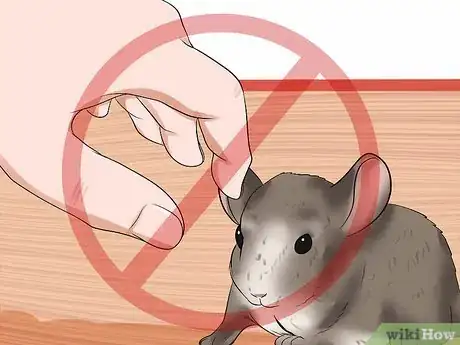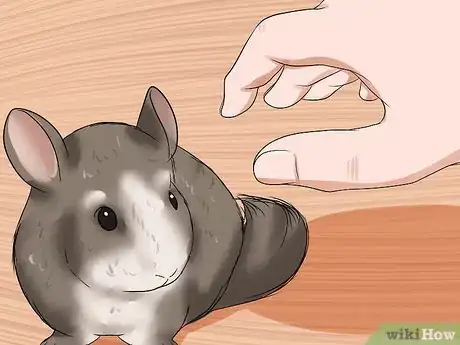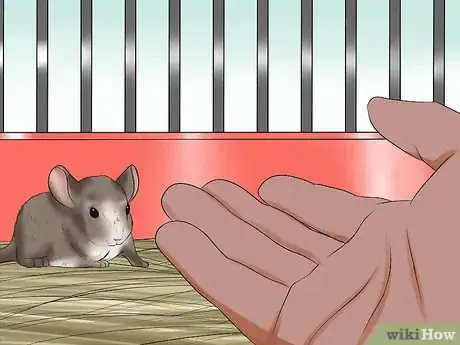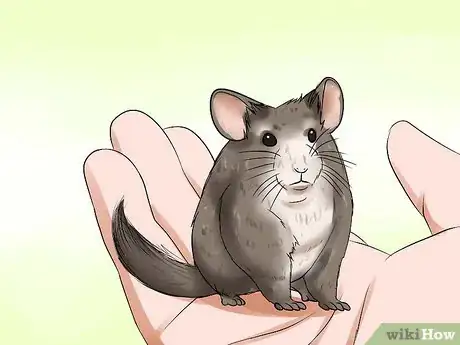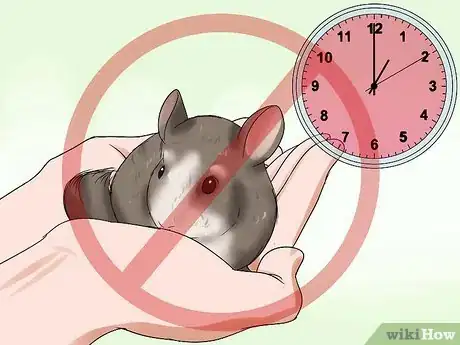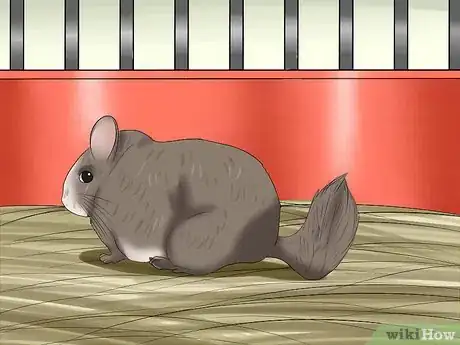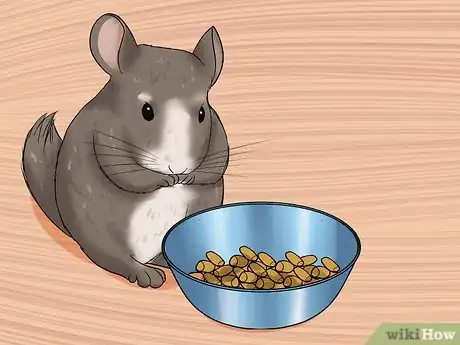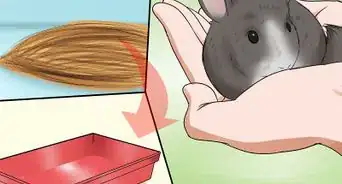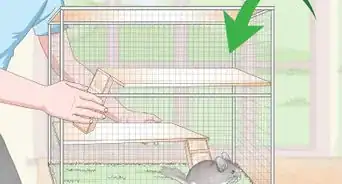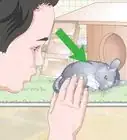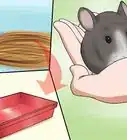This article was co-authored by Pippa Elliott, MRCVS. Dr. Elliott, BVMS, MRCVS is a veterinarian with over 30 years of experience in veterinary surgery and companion animal practice. She graduated from the University of Glasgow in 1987 with a degree in veterinary medicine and surgery. She has worked at the same animal clinic in her hometown for over 20 years.
wikiHow marks an article as reader-approved once it receives enough positive feedback. In this case, 84% of readers who voted found the article helpful, earning it our reader-approved status.
This article has been viewed 58,517 times.
Chinchillas can be wonderful pets, but they tend to have nervous temperaments, and a new pet chinchilla may be flighty, nervous and unwilling to spend time with you. This is normal for an animal with wild instincts and a preference for being among its own kind. The process to tame a pet chinchilla can take weeks and begins the day you bring your pet home. With love, patience and care, you can reassure your chinchilla that you are not a threat and train it into a wonderful pet.
Steps
Bringing Home a New Chinchilla
-
1Prepare an ideal home for your new pet. You cannot begin to tame your chinchilla until she feels safe and relaxed in her new home. Having a comfortable place set up for her when you bring her home will help her to adapt to her new environment with as little nervousness and anxiety as possible.
- Chinchillas are large rodents and they like to jump, so they require a large cage.
- Put a nesting box on the bottom level of the cage for your chinchilla. This provides a place where she can retreat if she wants to hide or have privacy.
-
2Make the first day count. Be sure that you are careful to avoid overstimulating or stressing her on her first day at your home.
- Offer her a single raisin as a good-will offering on the first day, but do not ply her with lots of treats. Her digestive system is sensitive and she needs to slowly adapt to her new diet.
Advertisement -
3Make her new environment calm. In addition to preparing an ideal home for your pet, you need to ensure that your home is calm and quiet for the first few weeks at least. Chinchillas and other rodents never really like a loud environment, but they can grow to tolerate more noise once they are adjusted and comfortable.
- Keep her in a quiet room, away from other pets, children, televisions, or other sources of noise.[1]
-
4Give her space. Leave your chinchilla alone for the first few weeks or so. This will allow the chinchilla to get used to its strange new surroundings.
- Feed and water her daily, and only handle her as much as needed to clean her cage (in most cases, you should be able to clean around her and not touch her at all).
- Talk in a soft, soothing voice to her when you are in the room. You may notice her hiding, squeaking, or barking for the first few days; these are signs of stress and should gradually become less common as you continue to gently reassure her and help her feel secure.[2]
Touching Your Chinchilla
-
1Do not try to hold or touch her right away. Your new chinchilla is overwhelmed right now, getting used to the sights and sounds of her new home. Some chinchillas are naturally friendly, but others are more anxious and may require a few days to weeks to get used to you before you should attempt to hold her. In the meantime, there are a few things you can try to help her get used to your scent and presence.
- For the first few days, simply spend time in her room, speaking to her in a calm and quiet voice through her cage.[3] While it is true that your chinchilla won't understand your words, she will understand your soothing tone and comforting presence. She will begin to associate you with safety.
- Open her cage door, and rest your hand just inside the cage. Do not try to grab or touch her or move your hand too quickly, though, or you might startle her. She may hide from your hand, but keep doing this at least once a day. Some chinchillas will come over and smell you and explore your arm right away; others will take weeks to get comfortable enough to move closer. Be patient.[4]
-
2Ease into petting her. When you feel that she has relaxed around you and is not acting agitated, you can start to make small movements with your fingertips to touch her fur. It's a good idea to do this while she is exploring your hand and arm through the open cage door, but be sure that you have the room secured in case she bolts out the open cage door.
- At first, your finger movements should be very subtle so as to not frighten her. As you test the waters, you can decide when it is safe to pet her more firmly. Always be gentle and never touch her face or near her tail.
- Be sure you do not make sudden movements or loud noises while handling her. Remember that chinchillas are often high strung and easily startled.
-
3Let her walk onto your hand. As she becomes more comfortable, she is likely to gradually walk onto your hand or arm, or perhaps even out of the cage and onto your lap. Let her explore, and keep her from falling, but do not grasp her or contain her. This will help her learn that you are trustworthy and not a threat.
- You may be tempted to offer her treats to coax her to come to you, but it’s a good idea to wait until you have established a trusting relationship before you begin to offer food (and then, only offer treats rarely, not routinely). Otherwise she may associate you with treats and not with companionship and will not be content to spend time with you without getting a reward.[5]
-
4Try to pick her up. Eventually she will have demonstrated that she is not stressed in your presence and feels comfortable touching you and with you touching her. This is a good time to gently pick her up.
- Sit on the ground so that she will not fall a far distance if she jumps from your hands.
- Always use two hands: one hand with an open palm to support under her tummy, and one hand to cover her back and help her feel secure. Never squeeze her rib cage, which is very fragile.
- Hold her close to your body for warmth and support. This will also help you keep control if she starts to struggle (which she is likely to do).
-
5Don't hold her for long periods. Even the most friendly, tame chinchilla does not like to feel contained and does not enjoy being held for long periods. They are curious and busy creatures who want to spend time exploring, not sitting still.
- Pay attention to her cues. Put her down immediately when she starts to squirm, squeak, or otherwise seems distraught or anxious.[6]
- Aim to hold her a couple of times a day for short periods of time, rather than trying to hold her for long periods.
- Don't introduce her to other people for a few months after you've tamed her, and then do so gradually and with patience, letting her take the lead by sniffing the person's hand and choosing if she wants to climb onto their open palm.
Troubleshooting a Problem Chinchilla
-
1Be patient with chinchillas who were not properly socialized. If you purchase your chinchilla at a young age, you are most likely to have success in properly socializing it to like being around humans. But if for some reason you acquire an older chinchilla who was not properly socialized as a younger animal, or one who has been neglected or mistreated, you will need to take special care to maximize your chances of taming it.[7]
- Before taking on such a pet, you should be aware that there are no guarantees that a poorly socialized pet can be rehabilitated. In some cases, you may never get to a point where your new pet will feel comfortable being handled or perhaps even being in the same room with you. If your pet was severely mistreated or is more anxious by nature, you may have to accept that the best you can do is keep her comfortable and well fed in her cage.[8]
-
2Recognize signs of stress. A stressed chinchilla requires extra patience and should not be handled until she relaxes. The most common signs of stress in a chinchilla are barking, squeaking, or trembling, as well as hiding from you when you approach. Some other signs might include:
- Spraying urine, or urinating all over the cage. While it is common for very young chinchillas to urinate in strange places (like in the nest, on a shelf, or directed to the outside of the cage), very stressed chinchillas also do this. Some female chinchillas even spray urine at predators, so if yours does this to you, it is a good indication that she is afraid of you and views you as a threat.
- Chewing hair or harming herself. Very stressed rodents (and other pets) sometimes chew their fur or otherwise harm their bodies.
- Some stressed chinchillas appear to never sleep, since they are always on alert and jump up at the first sound of your approach.
-
3Be patient with very stressed chinchillas. Patience is key. Chinchillas who are very fearful may require weeks of getting used to your presence by smelling your hand and hearing your voice before they will be comfortable with a light touch.
- If she is vocalizing or acting very panicky, do not approach the cage except to feed, water, and clean the cage. Do these things efficiently but not so quickly that you startle her more.
- Avoid looking her in the eye, which can be threatening to a rodent. Instead, sit near hear her cage and look toward her cage with closed eyes, and calmly say reassuring things like "Good girl."
- Try offering treats. While it is not a good idea to give treats to a pet chinchilla on a regular basis, a treat can go a long way as a peace offering, helping your chinchilla associate you with good things instead of fear. Try a few organic oat in the palm of your hand, to entice her to come near to you.
Expert Q&A
-
QuestionAre chinchillas litter box trainable?
 Pippa Elliott, MRCVSDr. Elliott, BVMS, MRCVS is a veterinarian with over 30 years of experience in veterinary surgery and companion animal practice. She graduated from the University of Glasgow in 1987 with a degree in veterinary medicine and surgery. She has worked at the same animal clinic in her hometown for over 20 years.
Pippa Elliott, MRCVSDr. Elliott, BVMS, MRCVS is a veterinarian with over 30 years of experience in veterinary surgery and companion animal practice. She graduated from the University of Glasgow in 1987 with a degree in veterinary medicine and surgery. She has worked at the same animal clinic in her hometown for over 20 years.
Veterinarian Yes, chinchillas are litter box trainable. Like most animals, they instinctively want to keep their toilet area separate from their eating and sleeping places. This means they readily learn to use an appropriate toileting area such as a litter box.
Yes, chinchillas are litter box trainable. Like most animals, they instinctively want to keep their toilet area separate from their eating and sleeping places. This means they readily learn to use an appropriate toileting area such as a litter box. -
QuestionDo chinchillas like being handled?
 Pippa Elliott, MRCVSDr. Elliott, BVMS, MRCVS is a veterinarian with over 30 years of experience in veterinary surgery and companion animal practice. She graduated from the University of Glasgow in 1987 with a degree in veterinary medicine and surgery. She has worked at the same animal clinic in her hometown for over 20 years.
Pippa Elliott, MRCVSDr. Elliott, BVMS, MRCVS is a veterinarian with over 30 years of experience in veterinary surgery and companion animal practice. She graduated from the University of Glasgow in 1987 with a degree in veterinary medicine and surgery. She has worked at the same animal clinic in her hometown for over 20 years.
Veterinarian As a prey species, chinchillas are not naturally sociable animals that enjoy being handled. However, with patience and gentleness, and by keeping rewards handy, you can teach them to accept being handled.
As a prey species, chinchillas are not naturally sociable animals that enjoy being handled. However, with patience and gentleness, and by keeping rewards handy, you can teach them to accept being handled. -
QuestionHow do you hold a chinchilla?
 Pippa Elliott, MRCVSDr. Elliott, BVMS, MRCVS is a veterinarian with over 30 years of experience in veterinary surgery and companion animal practice. She graduated from the University of Glasgow in 1987 with a degree in veterinary medicine and surgery. She has worked at the same animal clinic in her hometown for over 20 years.
Pippa Elliott, MRCVSDr. Elliott, BVMS, MRCVS is a veterinarian with over 30 years of experience in veterinary surgery and companion animal practice. She graduated from the University of Glasgow in 1987 with a degree in veterinary medicine and surgery. She has worked at the same animal clinic in her hometown for over 20 years.
Veterinarian First, make sure the chinchilla is tame and calm around you. Only then should you attempt to pick them up. Supporting them in both hands is best, so they feel secure. Never grasp a chinchilla by the fur as they may then shed their fur to escape.
First, make sure the chinchilla is tame and calm around you. Only then should you attempt to pick them up. Supporting them in both hands is best, so they feel secure. Never grasp a chinchilla by the fur as they may then shed their fur to escape.
Warnings
- Chinchillas will bite if they are stressed or afraid. If you rush the process of taming your chinchilla, she may bite you. Occasionally, rodent bites can cause illness or infection, so be sure to see a doctor if your chinchilla breaks your skin.⧼thumbs_response⧽
References
- ↑ http://www.smallanimalchannel.com/critter-experts/chinchilla/taming-a-terrified-chinchilla-1408.aspx
- ↑ http://www.foreverfeistychinchilla.org/chinchillas-and-their-guardians.html
- ↑ http://www.smallanimalchannel.com/critter-experts/chinchilla/taming-a-terrified-chinchilla-1408.aspx
- ↑ http://www.smallanimalchannel.com/critter-experts/chinchilla/taming-a-terrified-chinchilla-1408.aspx
- ↑ http://www.foreverfeistychinchilla.org/chinchillas-and-their-guardians.html
- ↑ http://www.foreverfeistychinchilla.org/chinchillas-and-their-guardians.html
- ↑ http://www.smallanimalchannel.com/critter-experts/chinchilla/taming-a-terrified-chinchilla-1408.aspx
- ↑ http://www.smallanimalchannel.com/critter-experts/chinchilla/taming-a-terrified-chinchilla-1408.aspx
About This Article
To tame your chinchilla, start by opening the door of its cage once a day and placing your hand in the opening so it can get used to your presence. Once it gets used to your hand, try petting it gently with your fingertips, making sure to avoid its face and tail. After a few days, allow your chinchilla to walk onto your open palm so it can explore and start to trust you. When it's no longer afraid of you, pick it up gently with both hands and hold it close to your body for warmth and support. For tips from our Veterinary co-author on how to recognize the signs of stress in your Chinchilla, read on!
